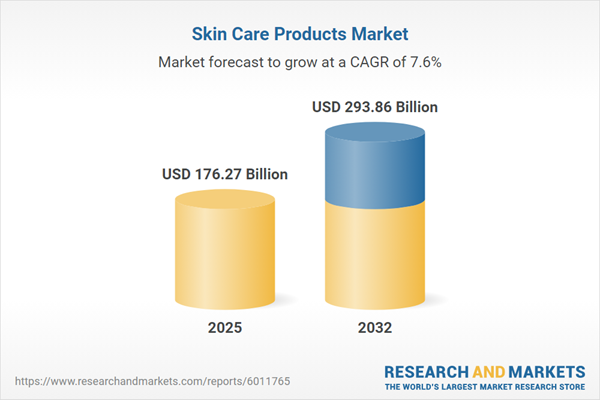Speak directly to the analyst to clarify any post sales queries you may have.
The skin care products market is undergoing notable transformation as digital adoption, new technology, and regulatory updates reshape competitive dynamics. Senior decision-makers require actionable insights and flexible strategies as evolving consumer expectations make successful navigation increasingly complex.
Market Snapshot: Skin Care Products Market Size and Growth
The global skin care products market has reached USD 163.82 billion and is expected to grow to USD 176.27 billion within a year, with projections pointing to USD 293.86 billion by 2032. The sector is advancing at a 7.57% compound annual growth rate. Key forces behind this growth include shifting consumer preferences toward health and wellness, increased focus on digital experiences, and accelerating product innovation. Brands are evolving portfolios and adopting digital-first and omnichannel models, which are changing how consumers access products and engage with brands. Regional market differences hold increasing importance, influencing launches and promotional approaches. Organizations aiming for successful expansion and differentiation must monitor these global and regional drivers closely.
Scope & Segmentation: Strategic Outlook for Senior Decision-Makers in the Skin Care Products Market
This report equips senior leaders with an in-depth framework to inform investments, drive innovation, and support strategic portfolio management within the skin care sector. Thoughtful segmentation analysis unlocks precise planning and greater adaptability, considering the following core dimensions:
- Product Types: Cleansers, creams, gels, foaming solutions, face masks, moisturizers, serums, and sunscreens. Each format allows tailored approaches to meet local demands and diversify offerings effectively.
- Distribution Channels: Pharmacy chains, specialty retail, supermarkets, hypermarkets, direct e-commerce, and third-party digital platforms. Building a solid presence across these channels improves omnichannel performance and strengthens consumer engagement.
- Skin Concerns: Solutions for acne, aging, pigmentation, dryness, and sensitivity. Designing products that address these issues helps capture growth in premium and clinical segments and builds consumer trust.
- End Users: Women, men, and unisex categories. Recognizing demographic changes enhances segment coverage and supports inclusive branding efforts.
- Regional Markets: Americas, Europe, Asia-Pacific, Middle East, and Africa. Adapting products and marketing to local customs, regulatory environments, and cultural preferences supports successful entry and sustainable growth.
- Key Companies: Analysis includes major incumbents and innovative new entrants, with coverage of research investments, development pipelines, and novel business models.
Key Takeaways
- Artificial intelligence and advanced analytics are streamlining consumer diagnostics and powering more personalized product solutions, enhancing engagement and efficiency for organizations.
- Sustainability initiatives are now central, influencing raw material sourcing, packaging decisions, and supply chain transparency, as ethical considerations become a core expectation for stakeholders.
- Robust omnichannel distribution helps brands maintain flexibility and resilience, positioning them to succeed in increasingly digital and interconnected retail environments.
- Collaboration within the industry and adoption of shorter product development cycles enable businesses to respond quickly to complexity and new competition.
- Emerging technologies such as biotechnology and microbiome research are catalyzing next-generation product pipelines, supporting credible science-based claims and expanding product value propositions.
- Adapting product design and packaging to fit regional preferences and comply with local standards improves market presence and ensures sustainable compliance.
Tariff Impact: Navigating 2025 U.S. Tariff Changes
Upcoming adjustments to U.S. tariffs will influence cost structures, particularly for imported raw materials and packaging. Senior leaders are advised to review supplier contracts, evaluate nearshoring opportunities, and collaborate with supply chain partners. Proactive scenario planning and open communication with stakeholders are critical to ensure operational continuity and regulatory compliance through this period of transition.
Methodology & Data Sources
Analysis draws on robust secondary industry research, direct interviews with senior executives, expert dermatologists, and distribution professionals. Findings are validated through internal and external review, supporting informed decisions for leaders in the skin care industry.
Why This Report Matters
- Equips senior leaders with intelligence to anticipate regulatory changes, shifting consumer behaviors, and evolving market structures across the global skin care products market.
- Supports smart investment and expansion by providing strategic insights into distribution trends, technology adoption, and effective portfolio management.
- Strengthens supply chain readiness and enables organizations to respond confidently to global competition and disruptive influences.
Conclusion
Proactive integration of data-driven foresight with agile operations positions organizations for continued progress. This report delivers the insight needed for senior teams to achieve adaptive, sustained success in the evolving skin care products sector.
Additional Product Information:
- Purchase of this report includes 1 year online access with quarterly updates.
- This report can be updated on request. Please contact our Customer Experience team using the Ask a Question widget on our website.
Table of Contents
3. Executive Summary
4. Market Overview
7. Cumulative Impact of Artificial Intelligence 2025
Companies Mentioned
The companies profiled in this Skin Care Products market report include:- L'Oréal S.A.
- Unilever PLC
- The Estée Lauder Companies Inc.
- Procter & Gamble Company
- Shiseido Company, Limited
- Johnson & Johnson
- Beiersdorf AG
- Amorepacific Corporation
- Kao Corporation
- Coty Inc.
Table Information
| Report Attribute | Details |
|---|---|
| No. of Pages | 188 |
| Published | October 2025 |
| Forecast Period | 2025 - 2032 |
| Estimated Market Value ( USD | $ 176.27 Billion |
| Forecasted Market Value ( USD | $ 293.86 Billion |
| Compound Annual Growth Rate | 7.5% |
| Regions Covered | Global |
| No. of Companies Mentioned | 11 |









